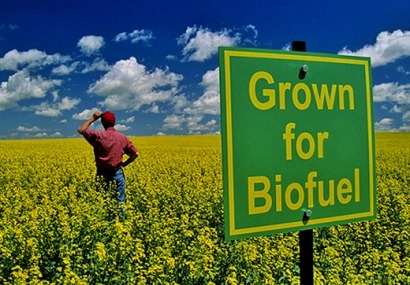
The United States and Brazil remain the two largest producers of ethanol. In 2010, the United States generated 49 billion litres, or 57 percent of global output, and Brazil produced 28 billion litres, or 33 percent of the total. Corn is the primary feedstock for US ethanol, and sugarcane is the dominant source of ethanol in Brazil.
“In the United States, the record production of biofuels is attributed in part to high oil prices, which encouraged several large fuel companies, including Sunoco, Valero, Flint Hills, and Murphy Oil, to enter the ethanol industry,” said Alexander Ochs, Director of Worldwatch’s Climate and Energy Programme, which prepared this latest study for the website Vital Signs Online. High oil prices were also a factor in Brazil, where every third car-owner drives a “flex-fuel” vehicle that can run on either fossil or bio-based fuels. Many Brazilian drivers have switched to sugarcane ethanol because it is cheaper than gasoline.
“Although the US and Brazil are the world leaders in ethanol, the largest producer of biodiesel is the European Union, which generated 53 percent of all biodiesel in 2010,” said Ochs. “However, we may see some European countries switch from biodiesel to ethanol because a recent report from the European Commission states that ethanol crops have a higher energy content than biodiesel crops, making them more efficient sources of fuel.”
New panorama in Argentina, Brazil, Canada, and China
Vital Signs authors Sam Shrank, a Worldwatch MAP Sustainable Energy Fellow, and Farhad Farahmand, a Climate and Energy research intern, also explored how new mandates in Argentina, Brazil, Canada, and China have altered the biofuel industries in these countries. “In Argentina, the biodiesel industry grew not only because of favourable conditions for growing soybeans, but also in response to a new B7 blending mandate, which requires the fuel to be 7 percent biodiesel and 93 percent diesel.” Accordingly, biodiesel producers in Argentina are investing heavily in facilities to increase production.
In the United States, however, the Environmental Protection Agency (EPA) made the decision to dramatically lower the country’s production target for cellulosic ethanol, a biofuel that is made from woody plants or crop waste and that can be converted to ethanol much more efficiently than conventional ethanol, resulting in lower associated greenhouse gas emissions. “The EPA’s target reduction reflects the technical challenges and high costs of commercializing so-called ‘second-generation’ biofuels,” said Shrank. “Instead of the 950 million liters required initially under the 2007 Energy Independence and Security Act, the final target will be a much smaller 25 million litres.”
Proposed legislation in the US Senate would cut current ethanol production subsidies while maintaining tax credits for related infrastructure such as refilling stations. If supports like subsidies and tariffs are removed in the United States, sugarcane ethanol from Brazil will likely become more prevalent. Although sugarcane ethanol has the benefit of being cheaper and more efficient to produce, there are concerns that increased production will speed deforestation in Brazil as more land is cleared for feedstock cultivation.
Further highlights from the report include:
• Due to unsteady ethanol production in Brazil in 2010, the United States became a net exporter of the fuel for the first time, sending a record 1.3 billion liters abroad, a 300-percent increase over 2009.
• Sugarcane ethanol supplies 41.5 percent of the energy (48 percent of the volume) for light-duty transportation fuels in Brazil.
• Asia produced 12 percent of the world’s biodiesel in 2010, a 20-percent increase from 2009, mostly using palm oil feedstock in Indonesia and Thailand.
• Virtually all of the 1.5 billion liters of Argentina’s biodiesel exports, representing 71 percent of total production, went to Europe.
• Canada has national mandates for the production of E5 (5 percent ethanol and 95 percent gasoline) and B2 (2 percent ethanol and 98 percent gasoline), and four Canadian provinces have individual mandates up to E8.5.
• In the United States, eliminating the $0.54 per gallon import tariff and $0.45 per gallon blenders’ credit would reduce the ethanol industry’s profits by 7 percent and its margins by 20 percent, according to the University of Missouri’s Food and Agricultural Policy Research Institute.
• Brazil plans to build 103 new sugarcane mills by 2019, increasing production capacity by 66 percent.
For additional information:

